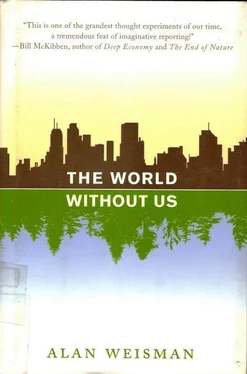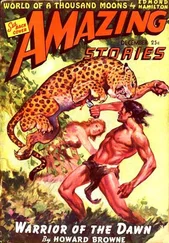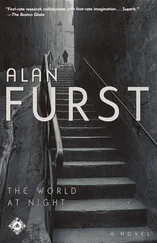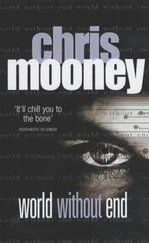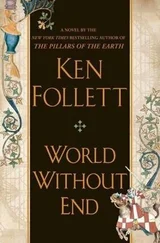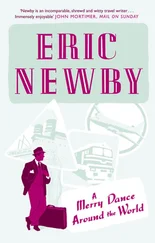Just beyond the river is Belarus; the radiation, of course, stopped for no border. During the five-day reactor fire, the Soviet Union seeded clouds headed east so that contaminated rain wouldn’t reach Moscow. Instead, it drenched the USSR’s richest breadbasket, 100 miles from Chernobyl at the intersection of Ukraine, Belarus, and western Russia’s Novozybkov region. Except for the 10-kilometer zone around the reactor, no other place received so much radiation—a fact concealed by the Soviet government lest national food panic erupt. Three years later, when researchers discovered the truth, most of Novozybkov was also evacuated, leaving fallow vast collective grain and potato fields.
The fallout, mainly cesium-137 and strontium-90, by-products of uranium fission with 30-year half-lives, will significantly irradiate Novozybkov’s soils and food chain until at least AD 2135. Until then, nothing here is safe to eat, for either humans or animals. What “safe” means is wildly debated. Estimates of the number of people who will die from cancer or blood and respiratory diseases due to Chernobyl range from 4,000 to 100,000. The lower figure comes from the International Atomic Energy Agency, whose credibility is tinged by its dual role as both the world’s atomic watchdog agency and the nuclear power industry’s trade association. The higher numbers are invoked by public health and cancer researchers and by environmental groups like Greenpeace International, all insisting that it’s too early to know, because radiation’s effects accumulate over time.
Whatever the correct measure of human mortality may be, it applies to other life-forms as well, and in a world without humans the plants and animals we leave behind will have to deal with many more Chernobyls. Little is still known about the extent of genetic harm this disaster unleashed: genetically damaged mutants usually fall to predators before scientists can count them. However, studies suggest that the survival rate of Chernobyl swallows is significantly lower than that of returning migrants of the same species elsewhere in Europe.
“The worst-case scenario,” remarks University of South Carolina biologist Tim Mousseau, who visits here often, “is that we might see extinction of a species: a mutational meltdown.”
“Typical human activity is more devastating to biodiversity and abundance of local flora and fauna than the worst nuclear power plant disaster,” dourly observe radioecologists Robert Baker, of Texas Tech University, and Ronald Chesser, of the University of Georgia’s Savannah River Ecology Laboratory, in another study. Baker and Chesser have documented mutations in the cells of voles in Chernobyl’s hot zone. Other research on Chernobyl’s voles reveals that, like its swallows, the life-spans of these rodents are also shorter than those of the same species elsewhere. However, they seem to compensate by sexually maturing and bearing offspring earlier, so their population hasn’t declined.
If so, nature may be speeding up selection, upping the chances that somewhere in the new generation of young voles will be individuals with increased tolerance to radiation. In other words, mutations—but stronger ones, evolved to a stressed, changing environment.
Disarmed by the unexpected beauty of Chernobyl’s irradiated lands, humans have even tried to encourage nature’s hopeful bravado by reintroducing a legendary beast not seen in these parts for centuries: bison, brought from Belarus’s Belovezhskaya Pushcha, the relic European forest it shares with Poland’s Białowieża Puszcza. So far, they’re grazing peacefully, even nibbling the bitter namesake wormwood— chornobyl in Ukrainian.
Whether their genes will survive the radioactive challenge will only be known after many generations. There may be more challenges: A new sarcophagus to enclose the old, useless one, isn’t guaranteed to last, either. Eventually, when its roof blows away, radioactive rainwater inside and in adjacent cooling ponds could evaporate, leaving a new lode of radioactive dust for the burgeoning Chernobyl menagerie to inhale.
After the explosion, the radionuclide count was high enough in Scandinavia that reindeer were sacrificed rather than eaten. Tea plantations in Turkey were so uniformly dosed that Turkish tea bags were used in Ukraine to calibrate dosimeters. If, in our wake, we leave the cooling ponds of 441 nuclear plants around the world to dry and their reactor cores to melt and burn, the clouds enshrouding the planet will be far more insidious.
Meanwhile, we are still here. Not just animals but people too have crept back into Chernobyl’s and Novozybkov’s contaminated zones. Technically, they’re illegal squatters, but authorities don’t try very hard to dissuade the desperate or needy from gravitating to empty places that smell so fresh and look so clean, as long as no one checks those dosimeters. Most of them aren’t simply seeking free real estate. Like the swallows who returned, they come because they were here before. Tainted or not, it’s something precious and irreplaceable, even worth the risk of a shorter life.
It’s their home.
CHAPTER 16

Our Geologic Record
ONE OF THE largest, and probably longest-lasting, relics of human existence after we’re gone is also one of the youngest. As the gyrfalcon flies, it lies 180 miles northeast of Yellowknife, Northwest Territories, Canada. If you flew over it today, it would be the very round hole half a mile wide and 1,000 feet deep. There are many huge holes here. This is the dry one.
Though, within a century, the rest may be, too. North of the 60th parallel, Canada contains more lakes than the rest of the world combined. Nearly half of Northwest Territories isn’t land at all, but water. Here, ice ages gouged cavities into which icebergs dropped when the glaciers retreated. When they melted, these earthen kettles filled with fossil water, leaving countless mirrors that sequin the tundra. Yet the resemblance to an immense sponge is misleading: because evaporation slows in cold climates, little more precipitation falls here than in the Sahara. Now, as the permafrost thaws around these kettles, glacial water held in place by frozen soil for thousands of years is seeping away.
Should northern Canada’s sponge dry out, that would also be a human legacy. For now, the hole in question and two recent smaller ones nearby comprise Ekati, Canada’s first diamond mine. Since 1998, a parade of 240-ton trucks with 11-foot tires, owned by BHP Billiton Diamonds, Inc., has lugged more than 10,000 tons of ore to a crusher 24 hours a day, 365 days a year, even at –60°F. The daily yield is a handful of gem-quality diamonds, worth well over $1 million.
They’re found in volcanic tubes that formed more than 50 million years ago, when magma bearing pure, crystallized carbon pushed up from deep below the surrounding granite. Even rarer than these diamonds, however, is what fell into the craters left by these lava pipes. This was the Eocene, when today’s lichen-covered tundra was a coniferous forest. The first trees that toppled in must have burned, but as everything cooled, others were buried in fine ash. Sealed away from air, then preserved by cold Arctic dryness, the fir and redwood trunks that diamond miners discovered weren’t even fossilized, but simply wood: intact, 52-million-year-old lignin and cellulose, dating back to when mammals were just expanding into niches vacated by dinosaurs.
One of the oldest mammal species on Earth still lives there, a Pleistocene relic that managed to survive because it was extraordinarily equipped to brave weather that ice-age humans preferred to escape. The chestnut pelage of the musk ox is the warmest organic fiber known, with eight times the insulating factor of sheep’s wool. Known in Inuit as qiviut , it renders musk oxen so impervious to cold that they’re literally invisible to infrared satellite cameras used to track caribou herds. Yet qiviut was nearly their downfall in the early 20th century, when they were all but exterminated by hunters who sold their hides in Europe for carriage robes.
Читать дальше
